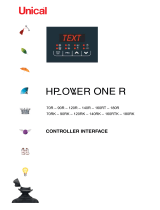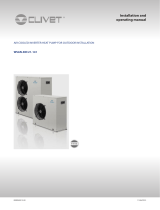
GB
2
SUMMARY
1 - GENERALITIES
1.1 - GENERAL SUPPLY CONDITIONS
• Generally speaking, the material is transported at the consignee’s risk.
•The consignee must immediately provide the carrier with written reserves if he finds any damage caused during transport.
1.2 - RECOMMENDATIONS
• Prior to all servicing or other actions on the equipment, installation, commissioning, operation, or maintenance, the
personnel in charge of these operations shall become familiar with the instructions and recommendations provided in the
installation manual of the unit as well as the elements of the project's technical file.
• The personnel responsible for receiving the unit must conduct a visual inspection in order to identify all damage to which
the unit may have been subjected during transport: refrigerating circuit, electrical cabinet, cassis and cabinet.
• The unit must be installed, started, maintained, serviced by qualified and authorised personnel, in compliance with the
requirements of all directives, laws and regulations and in accordance with standard trade practices.
• During installation, troubleshooting and maintenance operations, the use of pipes as a step: under the stress, the pipe may
rupture and the refrigerant may cause serious burns.
MARKING
This product marked conforms to the essential requirements of the Directives:
- Low voltage no. 2006/95/EC.
- Electromagnetic Compatibility no. 89/336 EEC, modified 92/31 and 93/68 EEC.
R 407 C
• Fluid R 407 C is not a pure fluid but a blend composed of:
- 23% R 32 + 25% R 125 + 52% R 134 A.
• The compressors approved for operation with this fluid are
filled beforehand with polyalcohol oil.
Contrary to mineral oil, it is very hygroscopic: it absorbs the
humidity of the ambient air very quickly. This can modify its
lubricant properties and lead in time to the destruction of the
compressor.
MAINTENANCE INSTRUCTIONS
1- Never add oil to the appliance; the compressor is filled
with polyalcohol oil, a special oil which cannot tolerate the
presence of other oils.
2-The instruments used for:
- filling,
- pressure measurements,
- emptying under vacuum,
- recovering the fluid,
must be compatible and only used for the R 407 C fluid.
3-The weight of the refrigerant contained in the storage
bottle must be checked constantly. Do not use it from the
moment the remaining weight is less than 10% of the total
weight.
4- In the case of a new charge:
- do not use the charging cylinder,
- use a balance and a dip pipe type R 407 C cylinder,
- charge the weight of R 407 C as per the value indicated
on the unit’s identification plate,
- IMPORTANT: see instruction 3 above.
5- The charge must be undertaken in liquid phase.
6- In case of leakage, do not complete the charge: recover
the remaining refrigerant for recycling and perform a total
charge.
Recovery, recycling or the destruction of the fluid must be
done in compliance with the laws in force in the country
concerned.
7-If the refrigerant circuit is opened, you must:
-avoid the entry of air into the circuit as much as
possible,
- replace the filter drier,
-perform the "vacuum operation" at a minimum level of
0.3 mbar (static).
8- Do not release R 407 C fluid into the atmosphere. This
fluid is a fluorinated greenhouse gases, covered by the
Kyoto Protocol with a Global Warming Potential
(GWP) = 1653 - (EC Directive 842 / 2006).
APPLIANCES FILLED WITH R 407 C
1 - Generalities . . . . . . . . . . . . . . . . . . . . . . . . . . . . . . . . . . . . . . . . . . 2
2 - Presentation . . . . . . . . . . . . . . . . . . . . . . . . . . . . . . . . . . . . . . . . . 3
3 - Installation . . . . . . . . . . . . . . . . . . . . . . . . . . . . . . . . . . . . . . . . . . . 4
4 - Connections . . . . . . . . . . . . . . . . . . . . . . . . . . . . . . . . . . . . . . . . . 4
5 - Operation of "ECH" electronic control . . . . . . . . . . . . . . . . . . . . . . 6
6 - Accessories . . . . . . . . . . . . . . . . . . . . . . . . . . . . . . . . . . . . . . . . . 11
7 - Starting . . . . . . . . . . . . . . . . . . . . . . . . . . . . . . . . . . . . . . . . . . . . 12
8- Maintenance instruction . . . . . . . . . . . . . . . . . . . . . . . . . . . . . . . 13
9 - Troubleshooting . . . . . . . . . . . . . . . . . . . . . . . . . . . . . . . . . . . . . 14
10 - Circulator curves . . . . . . . . . . . . . . . . . . . . . . . . . . . . . . . . . . . . . 14
11 - Pressure tables . . . . . . . . . . . . . . . . . . . . . . . . . . . . . . . . . . . . . . 15
12 - Wiring diagrams . . . . . . . . . . . . . . . . . . . . . . . . . . . . . . . . . . . . . 17






















